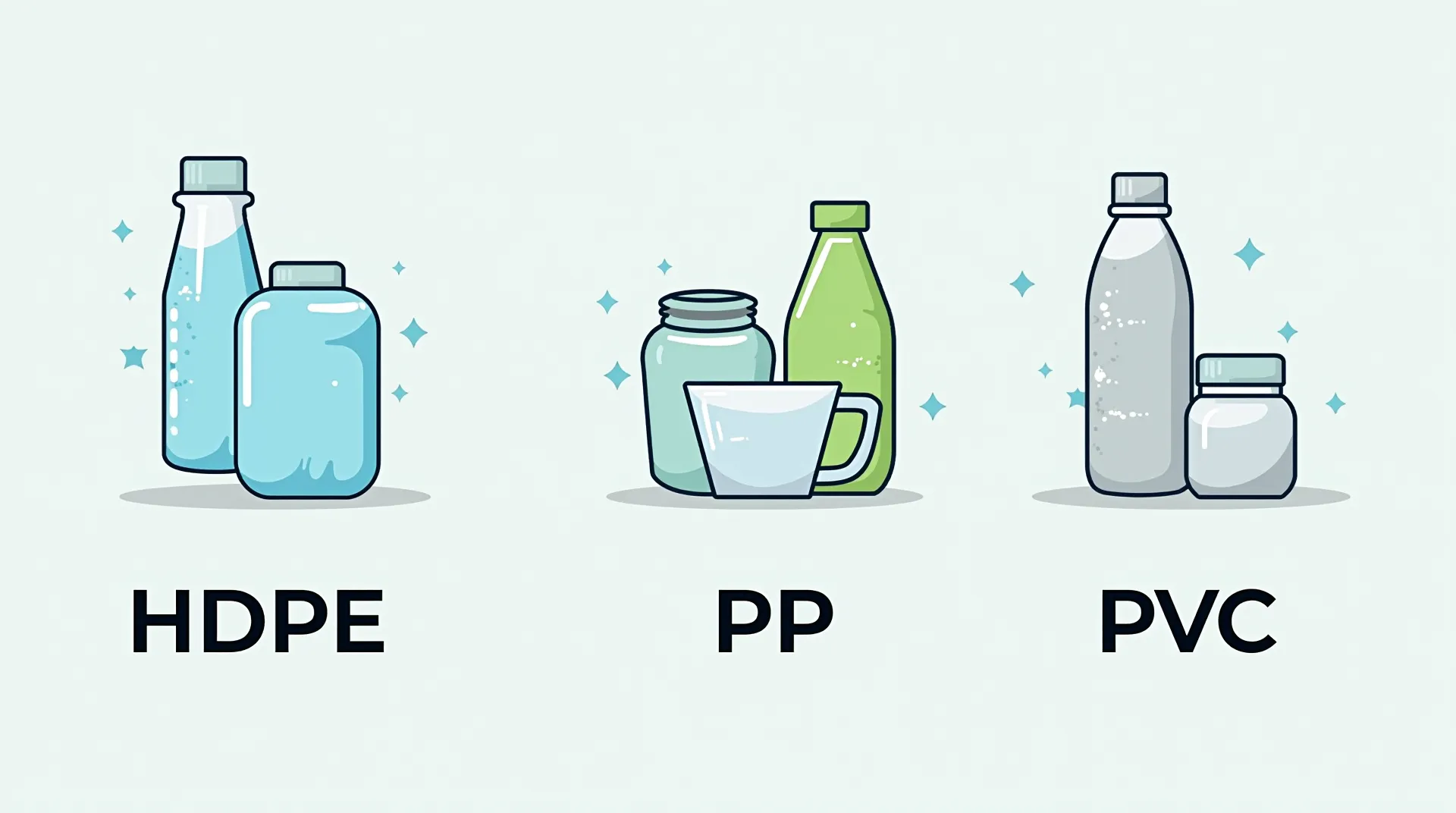Sztywne tworzywa sztuczne są podstawowymi materiałami w wielu branżach, cenionymi za wyjątkową trwałość, wszechstronność i wydajność produkcji. Są integralną częścią niezliczonych aspektów współczesnego życia, od codziennych udogodnień po zaawansowane osiągnięcia technologiczne. Ta eksploracja koncentruje się na niektórych z najbardziej rozpowszechnionych sztywnych tworzyw sztucznych, w tym polietylenie o wysokiej gęstości (HDPE), polipropylenie (PP) i polichlorku winylu (PVC), szczegółowo opisując ich odrębne cechy i różnorodne zastosowania.
1. Polietylen o wysokiej gęstości (HDPE) – wytrzymały i niezawodny wybór
Podstawowe właściwości i zalety:
- Wysoki stosunek wytrzymałości do gęstości: Zapewnia wyjątkową wytrzymałość przy zachowaniu niskiej wagi, co pozwala na optymalne wyważenie w zastosowaniach nośnych.
- Doskonała odporność chemiczna: Wykazuje wyjątkową odporność na szeroką gamę rozpuszczalników, kwasów i zasad, dzięki czemu nadaje się do stosowania w środowiskach o dużych wymaganiach chemicznych.
- Wyższa odporność na wilgoć: Absorbuje śladowe ilości wody, dzięki czemu doskonale nadaje się do stosowania w wilgotnych warunkach lub do pakowania płynów.
- Trwałe i odporne na uderzenia: Jego solidna konstrukcja pozwala mu wytrzymać poważne uderzenia, nie pękając ani nie łamiąc się łatwo.
Typowe obszary zastosowań:
- Pojemniki i butelki: Niezbędne do przedmiotów codziennego użytku, takich jak dzbanki na mleko czy butelki na detergenty, cenione za bezpieczeństwo i niezawodność.
- Rury i kształtki: Są szeroko stosowane w instalacjach hydraulicznych i nawadniających ze względu na ich sprawdzoną trwałość.
- Drewno z tworzyw sztucznych: Stosowany do produkcji mebli ogrodowych, tarasów i wyposażenia placów zabaw, łącząc walory estetyczne z odpornością na warunki atmosferyczne.
- Zabawki dla dzieci: Często wybierany do produkcji trwałych zabawek ze względu na swoją wysoką wytrzymałość i nietoksyczne właściwości.
2. Polipropylen (PP) – lekki i odporny na ciepło materiał uniwersalny
Podstawowe właściwości i zalety:
- Wysoka temperatura topnienia: Nadaje się do zastosowań wymagających wysokich temperatur, np. do pojemników na żywność nadających się do podgrzewania w kuchence mikrofalowej.
- Doskonała odporność na zmęczenie: Wytrzymują wielokrotne zginanie bez uszkodzeń, czego przykładem są zawiasy do kapsli.
- Szeroka odporność chemiczna: Skutecznie opiera się działaniu wielu powszechnie stosowanych kwasów, zasad i rozpuszczalników organicznych.
- Lekka: Posiada mniejszą gęstość niż wiele innych tworzyw sztucznych, co pozwala na produkcję lżejszych produktów końcowych.
Typowe obszary zastosowań:
- Części samochodowe: Stosowany do zderzaków, obudów akumulatorów i elementów wewnętrznych, skutecznie łącząc lekką konstrukcję z wytrzymałością.
- Opakowanie: Doskonale nadaje się do pojemników na żywność, zakrętek i zamknięć, zapewniając bezpieczeństwo i higienę produktu.
- Tekstylia: Wykorzystywany w dywanach, tapicerce i tkaninach nietkanych, co dowodzi jego wszechstronności.
- Urządzenia medyczne: Stosowany w strzykawkach i sprzęcie laboratoryjnym, ceniony ze względu na możliwość sterylizacji.
3. Polichlorek winylu (PCW) – wszechstronny i ekonomiczny materiał
Podstawowe właściwości i zalety:
- Wszechstronne właściwości mechaniczne: Mogą być produkowane w formie sztywnej lub elastycznej, w zależności od użytych dodatków.
- Dobra odporność chemiczna: Wykazuje odporność na kwasy, zasady i sole.
- Skuteczny izolator elektryczny: Stanowi idealny materiał izolacyjny w różnych zastosowaniach elektrycznych.
- Trwałe i długotrwałe: Skutecznie przeciwdziała degradacji w środowisku, zapewniając długą żywotność.
Typowe obszary zastosowań:
- Materiały budowlane: Ze względu na ekonomiczność i praktyczność jest szeroko stosowany do rur, ram okiennych i elewacji.
- Izolacja kabli elektrycznych: Chroni przewody elektryczne, zwiększając bezpieczeństwo elektryczne.
- Urządzenia medyczne: Stosowany do worków na krew, rurek i pojemników, znany ze swojego bezpieczeństwa i niezawodności.
- Dobra konsumpcyjne: Można je znaleźć w kartach kredytowych, zabawkach i różnych artykułach gospodarstwa domowego, dostępnych w różnych formach.
4. Politereftalan etylenu (PET/PETE) – gwiazda wśród przejrzystych i mocnych opakowań
Podstawowe właściwości i zalety:
- Wysoka wytrzymałość na rozciąganie: Łączy w sobie wytrzymałość i lekkość, co przekłada się na solidne i trwałe produkty.
- Doskonałe właściwości barierowe: Zapewnia dobrą odporność na gazy i wilgoć, co ma kluczowe znaczenie dla zachowania świeżości produktów w opakowaniu.
- Wysoka podatność na recykling: Należy do najczęściej poddawanych recyklingowi tworzyw sztucznych, co znacząco przyczynia się do ochrony środowiska.
- Wykończenie transparentne i błyszczące: Zapewnia estetyczny wygląd opakowania, zwiększając atrakcyjność produktu.
Typowe obszary zastosowań:
- Butelki na napoje: Materiał dominujący w produkcji butelek na napoje bezalkoholowe i wodę.
- Opakowania żywnościowe: Stosowany do tacek, pojemników i opakowań typu clamshell, zapewniając bezpieczeństwo i higienę.
- Tekstylia: Przetwarzane na włókna poliestrowe do produkcji odzieży i tapicerki.
- Elektronika: Stosowany w podzespołach urządzeń elektronicznych ze względu na swoje właściwości izolacyjne.
5. Polistyren (PS) – ekspert w dziedzinie formowania lekkiego i izolacyjnego
Podstawowe właściwości i zalety:
- Sztywne i przezroczyste: Zazwyczaj przejrzyste i twarde, zapewniające atrakcyjność wizualną wielu produktów.
- Dobry izolator: Zapewnia doskonałą izolację cieplną i elektryczną.
- Łatwe do formowania i kształtowania: Dzięki swojej formowalności nadaje się do tworzenia skomplikowanych wzorów.
Typowe obszary zastosowań:
- Materiały opakowaniowe: Zawiera opakowanie piankowe, jednorazowe sztućce i pudełka na płyty CD.
- Elektronika użytkowa: Tworzy obudowy telewizorów, komputerów i urządzeń.
- Sprzęt medyczny: Stosowany do przedmiotów jednorazowego użytku, takich jak strzykawki i pojemniki laboratoryjne.
- Zabawki i modele: Wybierany do przedmiotów szczegółowych i lekkich ze względu na łatwość formowania.
6. Akrylonitryl-butadien-styren (ABS) – wytrzymały i odporny na uderzenia plastik konstrukcyjny
Podstawowe właściwości i zalety:
- Wysoka odporność na uderzenia: Wyjątkowo wytrzymałe i odporne na uderzenia i wstrząsy.
- Dobra stabilność wymiarowa: Skutecznie zachowuje swój kształt przy naprężeniach i zmianach temperatury.
- Łatwe formowanie i obróbka mechaniczna: Ułatwia precyzyjną produkcję skomplikowanych części.
- Błysk: Mogą być produkowane z powierzchnią o wysokim połysku, odpowiednią do produktów o wysokich walorach estetycznych.
Typowe obszary zastosowań:
- Części samochodowe: Obejmuje elementy deski rozdzielczej, osłony kół i elementy wykończeniowe wnętrza.
- Elektronika użytkowa: Tworzy trwałe obudowy komputerów, drukarek i konsol do gier.
- Zabawki: Klocki LEGO są znanym przykładem zastosowania ABS w trwałych zabawkach.
- Sprzęt AGD: Stosowany w częściach odkurzaczy, lodówek i pralek.
7. Poliwęglan (PC) – wyjątkowo mocny materiał o wysokiej wydajności
Podstawowe właściwości i zalety:
- Wyjątkowa odporność na uderzenia: Praktycznie niezniszczalne, zapewniające doskonałą ochronę nawet w ekstremalnych warunkach.
- Wysoka przejrzystość: Zapewnia przejrzysty, szklany wygląd.
- Odporny na ciepło: Wytrzymują wysokie temperatury bez odkształcania się.
- Dobry izolator elektryczny: Nadaje się do różnorodnych zastosowań elektronicznych wymagających izolacji.
Typowe obszary zastosowań:
- Sprzęt bezpieczeństwa: Stosowany w hełmach, szkłach kuloodpornych i tarczach ochronnych.
- Dyski optyczne: Materiał pierwszego wyboru w przypadku płyt CD, DVD i Blu-ray.
- Komponenty samochodowe i lotnicze: Ceniony za tworzenie lekkich, a jednocześnie wytrzymałych części.
- Elektronika: Funkcje stosowane w ekranach smartfonów, obudowach laptopów i innych urządzeniach wyświetlających.
Szybkie porównanie popularnych sztywnych tworzyw sztucznych
| Rodzaj plastiku | Gęstość (g/cm³) | Wytrzymałość na rozciąganie (MPa) | Typowe zastosowania |
| HDPE (polietylen o wysokiej gęstości) | 0,93–0,97 | 20–37 | Butelki, rury, plastikowe drewno |
| PP (polipropylen) | 0,90–0,92 | 30–50 | Części samochodowe, opakowania, tekstylia |
| PVC (polichlorek winylu) | 1,16–1,58 | 50–60 | Rury, izolacja elektryczna, urządzenia medyczne |
| PET (politereftalan etylenu) | 1,38–1,40 | 55–75 | Butelki na napoje, tekstylia, elektronika |
| PS (polistyren) | 1,04–1,06 | 30–50 | Opakowania, obudowy urządzeń elektronicznych, zabawki |
| ABS (akrylonitryl-butadien-styren) | 1,04–1,06 | 40–50 | Zabawki, elektronika, części samochodowe |
| PC (poliwęglan) | 1,20–1,22 | 60–70 | Sprzęt bezpieczeństwa, dyski optyczne, elektronika |
Uwaga: Podane wartości są przybliżone i mogą się różnić w zależności od konkretnych receptur i procesów produkcyjnych.
Zagadnienia środowiskowe: sztywne tworzywa sztuczne i zrównoważona przyszłość
Podczas gdy zalety sztywnych tworzyw sztucznych są liczne, ich wpływ na środowisko jest istotnym czynnikiem. Jesteśmy zaangażowani w promowanie zrównoważonego rozwoju poprzez dedykowane praktyki:
- Zwiększanie możliwości recyklingu: Tworzywa sztuczne, takie jak PET i HDPE, są wysoce poddawane recyklingowi. Jesteśmy oddani zwiększaniu efektywności recyklingu, tym samym zmniejszając ilość odpadów i oszczędzając cenne zasoby.
- Optymalizacja produkcji: Ciągle poszukujemy bardziej energooszczędnych i przyjaznych dla środowiska procesów produkcyjnych, aby zmniejszyć zależność od zasobów nieodnawialnych.
- Odpowiedzialne gospodarowanie odpadami: W przypadku tworzyw sztucznych trudnych do recyklingu aktywnie poszukujemy odpowiednich metod ich utylizacji, mających na celu zminimalizowanie ich trwałości w środowisku i ochronę ekosystemów.
Nasze zaangażowanie w zrównoważone praktyki:
- Promowanie programów recyklingu: Zachęcamy społeczeństwo do szerokiego udziału w inicjatywach dotyczących recyklingu tworzyw sztucznych, aby wspólnie zmniejszyć obciążenie środowiska.
- Inwestowanie w materiały biodegradowalne i innowacyjne: Skupiamy się na badaniach i rozwoju biodegradowalnych tworzyw sztucznych i innych przyjaznych dla środowiska alternatyw oraz inwestujemy w nie, aktywnie poszukując bardziej ekologicznych rozwiązań materiałowych.
- Orędownictwo za racjonalnym wykorzystaniem: Promujemy wybór produktów wielokrotnego użytku i ograniczanie zużycia plastiku jednorazowego użytku, starając się w ten sposób przyczynić się do ochrony środowiska u źródła.
Wnioski: mądre wybory, wspólne kształtowanie przyszłości
Od odporności HDPE do potężnej wytrzymałości PC, każdy rodzaj sztywnego plastiku spełnia krytyczną rolę w nowoczesnym przemyśle i życiu codziennym, wyróżniając się unikalnym zestawem właściwości. Dogłębne zrozumienie ich cech i zastosowań nie tylko pozwala nam dokonywać świadomych wyborów materiałowych dostosowanych do konkretnych potrzeb, ale także podkreśla znaczenie zajmowania się wpływem na środowisko i promowania zrównoważonego rozwoju. Dzięki innowacyjnemu myśleniu i odpowiedzialnemu podejściu możemy wspólnie kształtować bardziej zrównoważoną i pomyślną przyszłość.



